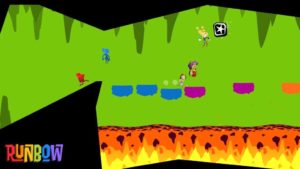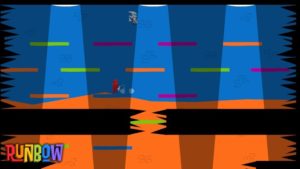Runbow (Switch, PS4, PC, Xbox One)
![]() Runbow is a fun, hyper-quick competitive platformer recently released on the PS4 and Switch (Switch version reviewed here, you can also read Cary’s excellent Wii U review.) Players (up to 9 online, 4 in local play) are placed down in a short platforming level and must race to be the first to touch the final trophy. It’s main shtick lies in the constantly changing solid color background. Most of the platforms are colored, and if they match the color of the background (essentially becoming invisible) the platform won’t support anyone. Players compete against each other in a series of short races to win the title for that series. Runbow is a fast playing game with minimal controls that manages to provide some great, intense multiplayer competition in nice short bursts.
Runbow is a fun, hyper-quick competitive platformer recently released on the PS4 and Switch (Switch version reviewed here, you can also read Cary’s excellent Wii U review.) Players (up to 9 online, 4 in local play) are placed down in a short platforming level and must race to be the first to touch the final trophy. It’s main shtick lies in the constantly changing solid color background. Most of the platforms are colored, and if they match the color of the background (essentially becoming invisible) the platform won’t support anyone. Players compete against each other in a series of short races to win the title for that series. Runbow is a fast playing game with minimal controls that manages to provide some great, intense multiplayer competition in nice short bursts.

The core of Runbow is the standard platformer race. Players race across the screen, hopping between platforms, avoiding traps, and trying to reach the trophy first. Character movement is simple, consisting of two buttons, jump and punch. A jump can be continued to a double jump, to get more height or distance. A simple punch with knock your opponent a little bit but the punch button can also be used for a dash-punch, a drop-punch (downward), and a very important leap-punch. One can even do a double-jump and then a leap-punch upwards to get across those extra-long gaps.
The controls are responsive (although I’m often messing up my final leap-punch) and their simplicity reflects the fast-paced simplistic ideal of the game. Since races are extremely short, the game focuses on a set of 5,10, or more short races. Players are all set down at the start of a level (levels go right to left as well as sometimes right to left) and they’re off and running. Basic platformer tropes apply, with falling rocks, moving platforms, lava, spikes, etc… The lead runner drags the frame of the game along with them, so slow players who fall behind the current screen are eliminated (for that one race.)
There are also powerups present on the level. They provide a random power, which adds chaos to the mix – very fitting for the style of game. Tagging a powerup automatically activates it and grants the player one of the following: a pair of boxing gloves (which eliminate an opponent with one punch), the ability to swap places with an opponent (for good or ill), a speed-up (for everyone, so harder to control) and even a mode which rotates the screen 180 degrees. Everyone is upside down, running the opposite direction on the ceiling.
The races are the primary game mode, but several others are available. A King of the Hill mode places a crown somewhere on the screen (which does not scroll.) Players attempt to jump and fight their way to the crown, and stay there for the requisite number of seconds. First to collect enough seconds wins the match. Unlike the races, players who fall to their death respawn after a few seconds, ready to head on up to the crown again. A second competitive mode is an all out brawl. Players are placed on a random level and must try to eliminate the others. Often this is simply a matter of hopping around long enough until the other players fall to their doom or encounter the deadly traps of that specific level. Finally, there is a story mode, and another, uber-challenging story mode where you start again from the beginning if you die on the way.

Verdict:
The Switch is simply the best pick-up and play and the best multiplayer console around. Runbow takes advantage of the Switch’s strengths and is a great little game the provides concentrated multiplayer fun in short bursts, perfect for an evening of multiplayer gaming. Sure, there are online modes, but for me the key is the multiplayer gameplay. Runbow takes a standard platformer idea, throws in a bit of a wrench (the color changing), but then provides a great set of essentially mini-games based around the platformer theme. Highly recommended to anyone who likes local multiplayer gaming.
Kid Factor:
All cosmic-colored cartoony goodness here. There’s lava and “splorching” when someone dies, but a cartoon skull and crossbones is all you get. If everyone dies on a level (which can be frequent) the game gives a snarky (but fairly tame) comment, while winners will see their character do a silly dance. So, not too much to worry about here age-wise. It may be a bit hard for the very young due to the innate difficulty, but most experienced gamers shouldn’t have too much trouble enjoying themselves.





Discussion Area - Leave a Comment